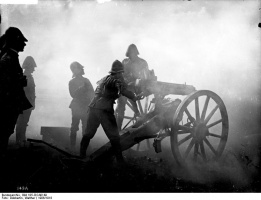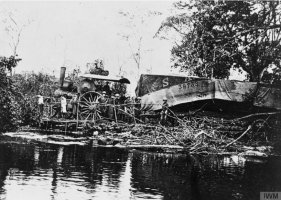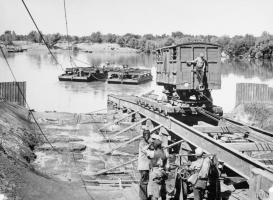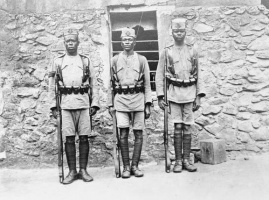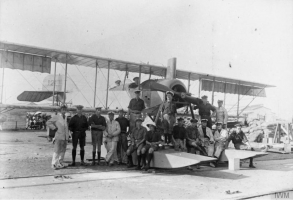Introduction↑
Many of the technologies and scientific advances that played a part in the First World War had been introduced worldwide during the 19th and early 20th century process of colonization. This was certainly true for Africa. As Daniel Headrick amply demonstrated, advances in engineering and medical technologies as well as weaponry and transportation systems were a significant part of European efforts to establish colonial control on the continent. In each of these four areas, African experiences during World War One, William K. Storey suggests, further “changed the ways in which people thought about technology” and its impact on their lives.[1]
Weapons↑
Experiences with colonial technologies conditioned Africans to expect new ideas and exploits in dealing with Europeans and this latest war intensified such awareness. In August 1915 science and technology on the battlefield became a stark reality for North African soldiers in Europe. Exposed to the German army’s first experiments with weaponized chlorine gas, many Algerian troops quickly died and more of their fellow soldiers fled. That one event gave rise to continuing questions on behalf of the Europeans about the fitness of African troops, overshadowing their other wartime accomplishments. Influenced by the experience of the Algerian soldiers in Europe, General Jan Smuts (1870-1950) in late 1916 contemplated using weaponized gas against German askari in east Africa, but practical considerations prevailed and his idea did not come to fruition.
Africans had a greater acquaintance with another ubiquitous weapon of the First World War: the machine gun. Used to devastating effect in European colonial expansion on the continent, by the time the world war began, many Africans were already familiar with its staggering firepower. All of the combatant countries equipped local forces with machine guns and began training Africans in their use, including men carrying the guns, tripods, and ammunition for the soldiers who actually fired them. Without a doubt, “the machine gun...[was] the most significant weapon regularly deployed” in Africa during the war[2] and thus quickly came to characterize this widespread conflict in the popular imagination. Throughout Malawi, for example, the conflict became known as “the chiwaya war” since the machine guns made a sound similar to the familiar noise produced by maize popping in tin utensils held over a fire.[3]
Associations of familiarity also led Africans to describe airplanes - first used in African colonial warfare less than a decade before the Great War - as mechanical birds (ndege in Swahili), and the bombs they sometimes dropped as eggs.[4] On the western front in Europe one wartime veteran of the Tirailleurs Sénégalais, Kande Kamara, made a somewhat different association, remembering that “steamships...flew in the air” above the battlefield.[5] And two years into the war, a South African soldier in central German East Africa, noted in his diary that when the first “aeroplane arrived natives [became] very excited.”[6] Even the lone zeppelin that ventured to Africa - an unsuccessful effort to resupply German East African forces - produced similar awe-inspiring reactions. When the huge zeppelin L59 cruised “low over the white roofs” of Dakhla Oasis west of the Nile in November 1917, its German crew reported seeing the “inhabitants kneel as...[the airship] approached and bow in the direction of Mecca.”[7]
Nonetheless, widespread use of aircraft as machines of war in European and African campaigns - whether for reconnaissance, as weapons, or even for “carrying mail”[8] and the occasional delivery of propaganda leaflets - led to a greater familiarity and a diminishing sense of wonderment. The German commander in East Africa Colonel, General Paul von Lettow-Vorbeck (1870-1964) reported in 1916 that when a British plane was shot down near Moshi, “it rather increased our prestige than otherwise.”[9] Soon Africans everywhere exhibited little surprise at the appearance of the European “birds,” seeing them as another mechanical device not unlike automobiles. And by the end of war, both had been incorporated into common African cultural expressions such as song, dance, and drama.
Transportation↑
Motorized transport - including automobiles, motor lorries and motorcycles - had come to various parts of the continent early in the 20th century. But without a doubt, it was the experiences of World War One that “introduced the internal combustion engine, and with it, motorable roads to many parts of Africa.”[10] European forces employed them in every African theatre and in some places - from Lake Malawi in the south to the Mediterranean sea docks in Alexandria - motor vehicles made an immediate impression. Even into the early 1920s the appearance of motor cars in some out-of-the-way East African hamlets led “to the astonishment of the populace.”[11] A Nigerian described the cars he saw during the Cameroon campaign as simply “canoes on wheels,”[12] while German askari viewed the few armoured cars they encountered as “the charging rhino which spits lead.”[13]
As the continuing war increased manpower demands, Africans themselves were recruited for motor transport duties. Members of the Cape Coloured Labour Battalion serving in France “for the most part were engaged as drivers and went right up to the firing lines with their cargoes,”[14] as did some Africans from the French colonies. As early as 1915 a few Rhodesian Africans were recruited as drivers, and soon after educated men in the Gold Coast enlisted as drivers for the East African campaign, as did others from Nigeria. Though largely successful in such service, the increasing numbers of African drivers did not compensate for inherent difficulties in using motorized transport in the various African campaigns.
Initially there were almost no appropriate roads, and certainly not in the bush country through which most troops and supplies passed. Even when existing paths and tracks were expanded, the new roads frequently became “too deep in mud or dust” to ensure easy passage while even small ruts and potholes slowed or stopped armoured vehicles.[15] River crossings were particularly difficult, with few bridges in place and even an abundance of crocodiles sometimes making what seemed to be potential fords problematic. On occasion an “aerial tramway” could be constructed from which “vehicles were swung across,”[16] while sometimes primitive pontoon bridges were devised for crossing, or cars were partially dismantled, transported by boat and then reassembled for use.
Retreating German forces in East Africa attempted to destroy or disable railway tracks and rolling stock as they abandoned territory. Allied forces re-laid some ripped out rails on which “motor lorries with adapted wheels” from some of the damaged rail cars “did duty as engines.”[17] Nonetheless, rail transport was of decreasing significance in the East African Campaign after mid-1916 as von Lettow-Vorbeck withdrew his forces south of the central railway. In Cameroon, the Allies captured significant functioning rail assets and, by May 1915, “the whole of the Northern Railway running for some 120 kilometers from Duala had been...placed in full working order.”[18] As the Egyptian Expeditionary Force continued the allied war effort against the Ottomans, thousands of mainly local laborers frantically worked to extend the rails east from Africa into Gaza. Other steam powered devices also came into military service, notably large traction engines which were used in the campaign to conquer German Southwest Africa and in transporting two Thames riverboats from South Africa to Lake Tanganyika.[19]
This expedition suggests the importance of naval technology in Africa during the war, especially the use of lake steamships as military transports. On Lake Malawi, German military authorities sent an agent to sabotage wood supplies for British lake steamers, although he was captured and executed before carrying out his plan. The Germans also re-captured the coastal tug Adjutant, disassembled and transported it by rail to Lake Tanganyika where it was ultimately destroyed in advance of an allied attack on Kigoma. Additionally, after abandoning the fatally crippled light cruiser Königsberg in the Rufigi River delta, where it had sought refuge from British Indian Ocean naval patrols, the Germans removed the ship’s guns to their naval workshops in Dar es Salaam for repair. Specially designed gun carriages then enabled them to be moved about on land, adding ten artillery pieces to von Lettow-Vorbeck’s forces.[20]
Engineering↑
Such naval re-engineering - as well as various automotive adaptations - was characteristic of responses to technical challenges common during the war, especially in Africa. By summer 1914 Germany had installed four high-powered wireless stations at Windhoek, Dar es Salaam, Douala and a major worldwide, state-of-the-art communications center at Kamina in Togo. As its capture might have enhanced allied communications, German colonial officials ordered destruction of the Kamina station “out of necessity” once Togo was invaded by British and French forces.[21] The other three principal German wireless outposts in Africa were also eliminated by allied actions; only that at Dar es Salaam was partially rebuilt. Suggestions that it was then used in a ruse by British agents to undermine the German attempt to resupply its East African Schutztruppe by zeppelin have, however, been proved unfounded.[22] Another effort to bolster von Lettow-Vorbeck’s wireless capabilities failed when the supply ship Rubens ran aground north of Tanga.
Military communication remained difficult in each of the African campaigns. Most commanders relied on dispatch runners, occasionally supplemented by airplanes, or more frequently, dispatch riders on motorcycles. The South African Motor Cyclist Corps operated in most areas of East Africa, although with mixed efficiency.[23] Occasionally, bicycles were used as well; von Lettow-Vorbeck personally used one on occasion. Belgian forces actually had a dedicated bicycle unit in the East African Campaign, not merely for communication but also in support of combat operations.[24] Nevertheless, less personal methods were actually more common. German forces in Cameroon attempted to use flag communications between fixed stations and the British relied on heliographic signals in East Africa when possible; however, such line-of-sight methods were frequently inadequate where topography or vegetation intervened. Both sides tried employing telegraph networks in Africa, sometimes improvising with barbed wire and using beer bottles or animal bones for insulation; in East Africa, though, migrating giraffe frequently disabled the carefully strung wires. To reduce the length of the lines - and conserve precious supplies - in the latter stages of both the Cameroon and East African campaigns Schutztruppe askari rolled up and then re-laid wire as they retreated although “the combination of wear and tropical weather degraded its performance.”[25]
The Germans, especially, tried creating substitutes for other military necessities. On Lake Victoria and in the Wouri Estuary of West Africa, Germans crafted makeshift torpedoes to use against British gunboats, though none were successfully deployed.[26] Also in Cameroon, severe shortages of ammunition led to a cottage industry remanufacturing shells. Similar efforts in East Africa, utilizing powder reserves from the Königsberg, supplied the Schutztruppe artillery. By late 1917, however, only plunder from Portuguese military posts provided the Germans with sufficient small arms ammunition. Despite the extensive use of porters in Africa, British supply officers expended considerable engineering ingenuity to keep their wheeled vehicles functional, adequate new roads created, as well as well as old ones repaired. In Egypt sand hampered all motorized travel unless vehicles were fitted with specially made wider wheels or chains with boards attached to facilitate movement across the soft surfaces.[27] In East Africa, German askari hand-carried at least one small six-pound gun from one engagement to another,[28] although larger guns required either animal, or sometimes mechanical, transport. But one twelve-pound gun was all a single car could tow, and if its path were impeded by rain-soaked roads or other obstacles, improvising bridges, pontoons, or rafts to transport artillery always depended on a great deal of African labor.
All these engineering feats, and the machines associated with them, had an impact on Africans, reinforcing ideas of the modern world and their ability to embrace it. Many learned to drive motor vehicles, taking up the same occupation or finding employment as mechanics at the end of the war. One Nigerian recalled learning basic concepts of mechanics through observation and practicing “how to take...rifles and machine guns…apart and put them together again.” Following demobilization he purchased his own tools and found employment “fixing things,” a demonstration of initiative replicated elsewhere on the continent.[29] With many white South African miners absent for war service, black miners broke through the industry’s color bar “in semi-skilled jobs...which had previously been reserved for whites.”[30] Similarly, in French West Africa, Africans were also employed in “a large number of fields hitherto predominantly occupied by Europeans” including “mechanics and surveyors of public works.” And with shortages of qualified medical professionals, French “colonial officials also decided to establish a medical school...[to] train African assistant-doctors.” as well.[31]
Medicine↑
“Modern,” western medical care had only come to Africa with colonialism, though wartime medical practice was often in crisis. In fact, a 1917 British War Office inquiry concluded that there was “much to regret in the medical history” of the East African Campaign.[32] But for many Africans in France, medical care was generally even better than they experienced in West Africa. “Tirailleurs sick or wounded, once evacuated from their regimental infirmary, were [often] directed...to one of the hospitals especially for Senegalese.” These were usually well organized and fully staffed, offering the most medically advanced care and even featured added attentions from “the ladies of the Red Cross,” whom one patient, Bakary Diallo, described as “angels.”[33]
In Africa such attentiveness was rare. British and other allied doctors did their best to apply their specialized knowledge in new environments. “The thick bush...was no place for a dressing station,” Dr. Francis Brett Young (1884-1954) complained of his situation in East Africa, but concluded “it was doubtful if anywhere in this unchanging bush we should find better.”[34] Even military hospitals were often makeshift affairs in abandoned or confiscated buildings, using what equipment that might readily be at hand, and thus were frequently scenes of chaos more than order. Often medical supplies were woefully deficient, requiring “the necessity of improvisation;”[35] one South African battalion commander even privately ordered supplies of quinine for his soldiers. But the German commander nonetheless believed that his forces “never had any difficulty in improvising whatever was necessary” in caring for the wounded,[36] despite being “deprived of medicines and forced to create dressings from plants.” German doctors did emphasize “prevention rather than intervention,” and thus were more successful in treating malaria amongst their troops.[37]
Certainly neither the French nor British armies in Africa were so well staffed or supplied to meet medical needs as were their German adversaries, though near the end of the East African Campaign, von Lettow-Vorbeck on several occasions left some of his sick and wounded behind believing his pursuers could better care for them. A full Belgian field hospital was ordered to south-eastern Tanganyika just to do so. Allied armies based in East Africa also made an effort to train Africans to assist in the care of the sick and wounded. Some Nigerians “received special training...as medical assistants for base and field hospitals.”[38] British authorities trained a Uganda Native Medical Corps, later expanded into an African Native Medical Corps whose members served with “markedly favourable” results from the Ethiopian border to Northern Rhodesia.[39] In Nyasaland the success of mission enlisted “dispensary boys” was so great, following the war their training was intensified with some “of the more senior boys [placed] in charge of a village dispensary” or other significant medical care positions.[40] The wartime success in the spread of medical training thus had a direct impact on colonial medical practice.
Nonetheless, the immediate post-war period brought other medical difficulties for the demobilized troops and the beleaguered general population. The great influenza pandemic of 1918-1919 presented a particular challenge all across the continent. In August 1918 German doctors thought they were dealing with pneumonia, not influenza; some British military doctors at first believed that demobilized carriers and soldiers were simply “malingering” and at worst “suffering slightly from bronchitis.”[41] But as the disease spread and shortages of effective medicines became acute, hard-pressed colonial officials scrambled to offer more up-to-date, if seemingly unconventional, medical advice. One such admonition offered Africans was that they “combat the influenza by dissolving wood ash in water, sieve the solution, and drink the solute.” Such an improvised suggestion, though, was remarkably similar to many alkaline-based treatments advocated in standard medical journals of the time - and also akin to some African traditional treatments - and thus made sense to Africans who were becoming accustomed to European medical advice.[42]
Despite difficulties and war-induced improvisation in medical practice, many Africans remained grateful for the care they received. Even years later, numerous triailleurs fondly recalled the quality of care they received from military doctors and in French hospitals. One Nigerian veteran, Private Oyeleke, remained certain he owed his long term survival to British military doctors teaching him “how to live long.” Despite the unexpectedly high mortality rates from wartime service and the subsequent influenza outbreak, Africans seemed to be impressed by the medical, and other technological experiences of the war. The soldiers, carriers and others drawn into the conflict, “and perhaps their families and friends [were] more likely to accept modern technology in general and western medicine in particular.”[43]
Conclusion↑
In Africa as elsewhere the impact of science, and especially its application to medical treatment and technological innovation, highlighted “the most awe-inspiring, destructive, and capricious demonstration of European...power displayed in the most terrifying way,” especially during the longest of all World War One campaigns, that in eastern Africa.[44] “Our assegais [spears] are no good now,” one South African Native Labour Contingent veteran bemoaned; “they cannot reach an aeroplane.”[45] While “participation in the great war quickened the consciousness” of many Africans who embraced and adapted to new ways they experienced during wartime,[46] for many it did not. Among the Nandi of Kenya, for example, even veterans seemed to have had “neither the desire nor the skills to become active in fashioning the [new] economy...such as it was in the 1920s.”[47] Though “few...[African] families were unaffected,” the full impact of the war “was not apparent” to many of them.[48] Remembering the trials of wartime Kenya, Isak Dinesen, known as Karen Blixen (1885-1962) believed that “of all our activities in the land, of the scientific and mechanical progress there,…the only practical use” Africans had for the awesome power of European technology on display during the First World War was a hope that somehow it might deliver them from misfortune.[49] Even so, any such expectations of wartime technologies seem, at best, to have only been partially fulfilled.
Melvin E. Page, East Tennessee State University
Section Editor: Richard Fogarty
Notes
- ↑ Storey, William K.: The First World War: A Concise Global History, Lanham 2009, pp. 3-4.
- ↑ Strachan, Hew: The First World War in Africa, Oxford 2004, p. 11 and p. 104.
- ↑ Page, Melvin E.: The Chiwaya War: Malawians and the Great War, Boulder 2000, p. 3. Chiwaya is the word in Chichewa, the most widely spoken language in Nyasaland; Scott, David Clement and Heatherwick, Alexander: Dictionary of the Chichewa Language. 1929; reprint Blantyre, Malawi 1970, p. 91. Similarly, the word in Yao, spoken by many Nyasaland askari, is ciwaya; Sanderson, G. Meredith: A Dictionary of the Yao Language. Zomba, Nyasaland 1954, p. 64.
- ↑ Buchanan, Angus: Three Years of War in East Africa, London 1919, p. 29; also Hoyt, Edwin P.: Guerilla, New York and London 1981, p. 100.
- ↑ Lunn, Joe Harris: Kande Kamara Speaks: An Oral History of the West African Experience in France 1914-1918, in: Page, Melvin E.: Africa and the First World War, London 1987, p. 39.
- ↑ Thompson, E.S.: A Machine Gunner's Odyssey Through German East Africa: Part 3, 18 September 1916-26 February 1917, in: Military History Journal (South Africa) 7/6 (1988), http://samilitaryhistory.org/vol076et.html, entry dated 6 Nov 1916 (retrieved 24 March 2015).
- ↑ Robinson, Douglas H.: The Flight to Africa of the German Naval Airship L59, in: American Aviation Historical Society Journal 4/2 (1959), p. 118.
- ↑ Chikwenga, Aibu: An Autobiography, Baker, C. A. (trans. and ed.), in: Society of Malawi Journal 25/2 (1972), p. 18.
- ↑ Lettow-Vorbeck, Paul von: My Reminiscences of East Africa, London 1920, p. 81.
- ↑ Crowder, M.: The First World War and its consequences, in: Boahen, A. Adu: General History of Africa, VII: Africa Under Colonial Domination, 1880-1935, Paris and London 1985, p. 304.
- ↑ Mitchell, Philip: African Afterthoughts, London 1954, p. 39.
- ↑ Quoted in Matthews, James K.: “Nwose’s Tale,” Der Angriff: A Journal of World War I History (15 November 1981), p. 11.
- ↑ Whittall, W.: With Botha and Smuts in Africa. London 1917, pp. 189-190. Similar reactions were common elsewhere; see plate 6, “KAR askari with motor transport, Nyasaland,” in Page, Africa and the First World War 1987.
- ↑ Our Natives at the Front, in: South Africa 116 (1917), p. 483.
- ↑ Dolby, Robert V.: Sketches of the East African Campaign, London 1918, p. 54.
- ↑ McLaughlin, Peter: Ragtime Soldiers: The Rhodesian Experience in the First World War, Bulawayo 1980, p. 44.
- ↑ Shackleton, C. W.: East African Experiences 1916, Durban 1940, pp. 122-123.
- ↑ Strobart, S.E.M.: The Cameroons. National Review (U.K.) 66 (1915-1916), p. 435.
- ↑ Shankland, Peter: The Phantom Flotilla: The Story of the Africa Naval Expedition 1915-1916, London 1968 and Foden, Giles: Mimi and Toutou’s Big Adventure: The Bizarre Battle of Lake Tanganyika, New York 2005.
- ↑ Hall, Darrell D.: German Guns of World War I in South Africa. Military History Journal (South Africa) 3 (1974-1976), p. 53, http://samilitaryhistory.org/vol032dh.html (retrieved 5 April 2015); also Hoyt, Edwin P.: Germans Who Never Lost, New York 1968 and London 1969.
- ↑ Quoted in Maroix, J.E.P.: Le Togo Pays d’Influence Française, Paris 1938, p. 68.
- ↑ Robinson, Airship L59, 1959, p. 118; Villard, Henry S.: The Flight of Zeppelin L59, in: Cross&Cockade, 23 (1992), p. 77.
- ↑ Blair, Ashley: B. S. A.s in German East Africa: The Extraordinary Saga of the South African Motor Cyclist Corps and their 400 B.S.A.s in World War I, New Zealand BSA Motorcycle Owners Club (no date), http://bsa.org.nz/index.php/stories/b-s-a-in-german-east-africa?showall=1&limitstart (retrieved 16 March 2014).
- ↑ Muller, Emmanuel: Les Troupes du Katanga et Les Campagnes d’Afrique, 1914-1918, Brussels 1935, pp. 143-151.
- ↑ Strachan, Africa 2004, p. 125.
- ↑ Proceedings of HMS Cumberland and the Operations in the Cameroons: Part II, in: Naval Review 3/3 (1915), p. 513, http://www.naval-review.com/issues/1910s/1915-3.pdf, (retrieved 29 March 2015); Chatterton, E. Keble: Gallant Gentlemen, London 1931, pp. 134-138 and Chatterton, E. Keble: The “Königsberg” Adventure, London 1932, p. 268.
- ↑ Briggs, Martin S.: Through Egypt in War-Time, London 1918, p. 16 and 260; Bowman-Manifold, M. G. E.: An Outline of the Egyptian and Palestine Campaigns, 1914-1918, Chatham 1922, p. 21.
- ↑ Deneys Reitz, Trekking On, London 1933, p. 115.
- ↑ Private Oyeleke, quoted in Matthews, James K.: World War I and the Rise of Nationalism: Nigerian Veterans as Catalysts of Change, in: The Journal of Modern African Studies 20/3 (1982), p. 496.
- ↑ Katzenellenbogen, S. E.: Southern Africa and of War of 1914-1918, in: Foot, M.R.D.: War and Society: Historical Essays in Honor and Memory of J. R. Western 1928-1971, London 1973, pp. 114-115.
- ↑ Crowder, Michael: West Africa and the 1914-1918 War, in: Bulletin, de l’I. F. A. N. 30 ser. B/1 (1968), p. 240.
- ↑ Paice, Edmund: Tip & Run: The Untold Tragedy of the Great War in Africa, London 2007, pp. 393-394.
- ↑ Quoted in Balesi, Charles John: From Adversaries to Comrades-in-Arms: West Africans and the French Military, 1885-1918, Waltham 1979, pp. 166 and 106-107.
- ↑ Young, Francis Brett: Marching on Tanga, New York 1918, pp. 135-136.
- ↑ Dolby, East African Campaign 1918, p. 67.
- ↑ Lettow-Vorbeck, My Reminiscences 1920, p. 46.
- ↑ Strachan, Africa 2004, pp. 124-125.
- ↑ Matthews, Catalysts of Change 1982, p. 495.
- ↑ Keane, G. J.: The African Native Medical Corps, in: Journal of the Royal African Society 19 (1919-1920), pp. 298, 300-302.
- ↑ Blood, A. G.: The History of the Universities’ Mission to Central Africa, vol. II, 1907-1932, London 1957, p. 270.
- ↑ This was an assessment made by the 1/2 King’s African Rifles medical officer in February 1919; quoted in Page, Melvin E.: The ‘Fluenza on the Road to Vua, paper presented at conference on The Spanish Flu 1918-1918: Reflections on the Influenza Pandemic of 1918-1919 after 80 Years, Cape Town, 4 September 1998.
- ↑ Page, Chiwaya War 2000, pp. 173-174.
- ↑ Matthews, Catalysts of Change 1982, p. 496.
- ↑ Ranger, T. O.: Dance and Society in Eastern Africa, 1890-1970, Berkeley and Los Angeles 1975, p. 45 and 51.
- ↑ Quoted in Grundlingh, Albert: The Impact of the First World War on South Africans Blacks. In: Page, Africa and the First World War 1987, p. 60.
- ↑ “The Consciousness of Colour.” In: South Africa 121 (1919), p. 329.
- ↑ Greenstein, Lewis J.: The Nandi Experience in the First World War. In: Page, Africa and the First World War 1987, p. 88.
- ↑ Strachan, Africa 2004, p. 12 and 184.
- ↑ Dinesen, Isak: Out of Africa. New York 1985), p. 111; also see Page, Melvin E.: The Myth of the Brass Serpent: Europeans and the Protection of African Civilians during the East African Campaign. In: Ruano, E. Benito & Burgos, M. Espandes: 17th International Congress of Historical Sciences Proceedings vol. II. Madrid 1991, pp. 1044-1051.
Selected Bibliography
- Abbott, Peter / Ruggeri, Raffaele: Armies in East Africa 1914-18, Oxford 2002: Osprey.
- Anderson, Ross: The forgotten front. The East African campaign, 1914-1918, Stroud 2004: Tempus.
- Balesi, Charles John: From adversaries to comrades-in-arms. West Africans and the French military, 1885-1918, Waltham 1979: Crossroads Press.
- Through swamp and forest. The British campaigns in Africa, London 1917: Harrison, Jelring, & Co, 1917.
- Crowder, Michael: West Africa and the 1914-1918 war, in: Bulletin de l’IFAN 30, 1968, pp. 227-241.
- Crowder, Michael: The First World War and its consequences, in: Boahen, Albert Adu (ed.): General history of Africa. Africa under colonial domination, 1880-1935, volume 7, London; Berkeley 1985: Heinemann; University of California Press, pp. 283-313.
- Echenberg, Myron J.: Colonial conscripts. The Tirailleurs Sénégalais in French West Africa, 1857-1960, Portsmouth; London 1991: Heinemann; J. Currey.
- Farwell, Byron: The Great War in Africa, 1914-1918, New York 1986: Norton.
- Headrick, Daniel R: The tools of empire. Technology and European imperialism in the nineteenth century, New York 1981: Oxford University Press.
- Katzenellenbogen, Simon E.: Southern Africa and the war of 1914-1918, in: Foot, Michael Richard Daniell (ed.): War and society. Historical essays in honor and memory of J. R. Western, 1928-1971, London 1973: Paul Elek, pp. 107-121.
- Lettow-Vorbeck, Paul von: My reminiscences of East Africa, London 1920: Hurst and Blackett.
- Lord, Cliff: Military signalling in East Africa, in: Military History Journal 12/5, 2003, pp. 170-173.
- Matthews, James K.: World War I and the rise of African nationalism. Nigerian veterans as catalysts of change, in: The Journal of Modern African Studies 20/3, 1982, pp. 493-502.
- Page, Melvin E.: The Chiwaya war. Malawians and the First World War, Boulder 2000: Westview Press.
- Page, Melvin E. (ed.): Africa and the First World War, New York 1987: St. Martin's Press.
- Paice, Edward: Tip and run. The untold tragedy of the Great War in Africa, London 2007: Weidenfeld & Nicolson.
- Ranger, Terence: Dance and society in Eastern Africa, 1890-1970. The Beni Ngoma, Berkeley 1975: University of California Press.
- Robinson, Douglas H.: The flight to Africa of the German naval airship L59, in: American Aviation Historical Society Journal 4/2, 1959, pp. 110-123.
- Storey, William Kelleher: The First World War. A concise global history (2 ed.), Lanham 2014: Rowman & Littlefield Publishers.
- Villard, Henry S.: The flight of Zeppelin L59, in: Cross & Cockade 23, 1992, pp. 75-77.
- Walmsley, Leo: An airman’s experiences in East Africa 2, in: Blackwood’s Edinburgh Magazine 207, 1920, pp. 53-69 & 189-209.
- Walmsley, Leo: An airman’s experiences in East Africa 1, in: Blackwood’s Edinburgh Magazine 206, 1919, pp. 633-653 & 788-810.





